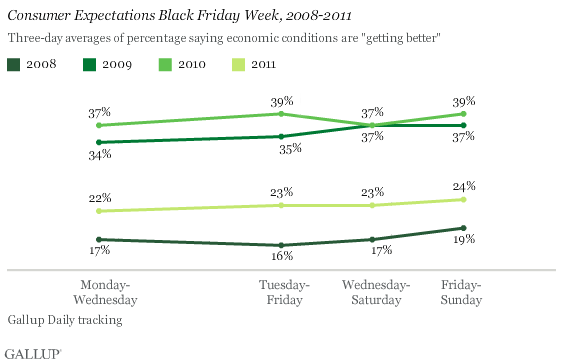PRINCETON, NJ -- Self-reported daily consumer spending in stores, restaurants, gas stations, and online averaged $98 per day for the three-day period ending Nov. 27. This is up from $92 a year ago and exceeds the Black Friday spending of each of the past three years.

Gallup's findings are consistent with the 6.6% increase reported by ShopperTrak. Consumer spending was higher in the days leading up to Thanksgiving this year than at any time since 2008. Average spending for the Black Friday week ending Nov. 27, 2011, was $83 and exceeds the weekly comparables for 2009 ($69) and 2010 ($79).
Spending Up Despite Low Economic Confidence
Even as consumers are spending more during Black Friday week, Americans remain substantially more pessimistic about the future course of the U.S. economy than they were at this time in 2009 and 2010. More than one-third of consumers said the economy was "getting better" during Black Friday week in 2009 and 2010. Now, less than one in four Americans say the economy is improving -- not much better than the less than one in five who said this during this same week in 2008.

Implications
Self-reported consumer spending for the days leading up to Black Friday and those for the first few days of the Christmas shopping season -- which, for many retailers, started on Thursday this year -- should be encouraging to the nation's retailers. So should the recent increase in Gallup's Christmas spending estimates.
Gallup's 2008 spending results show that consumers sometimes continue to spend even when their overall expectations for the economy are exceedingly low. This appears to be the case in 2011, although further confirmation is needed when consumers' Cyber Monday spending is reported over the next few days.
In part, the improvement in spending might be attributable to a modest improvement in Americans' economic optimism during November. Gallup's Economic Confidence Index shows a modest improvement in November. A similar increase in November consumer confidence is likely to be reported by the Conference Board on Tuesday.
Another part of the explanation might be related to the "new normal" spending patterns of the past few years. Consumers seem to be watching their spending closely while looking for bargains. Black Friday is known for retailer promotions and special sales for those who shop early. Further, some consumers seem able and willing to spend during special times like the holidays. "Frugality fatigue" seems to win out when Americans have a good excuse to go shopping for such special events as Back to School, Halloween, and Christmas.
Retailers have been aggressive again this year. Many opened on Thanksgiving Day and pursued heavy promotions and deep price discounting. So it might be that the big Black Friday success could end up simply borrowing sales from the remainder of the holiday sales season. Regardless, consumers seem to be in the mood to spend right now, and retailers might be wise to aggressively take advantage of it.
Gallup will continue reporting on daily spending trends during the remainder of the holiday season.
Gallup.com reports results from these indexes in daily, weekly, and monthly averages and in Gallup.com stories. Complete trend data are always available to view and export in the following charts:
Daily: Employment, Economic Confidence and Job Creation, Consumer Spending
Weekly: Employment, Economic Confidence, Job Creation, Consumer Spending
Read more about Gallup's economic measures.
View our economic release schedule.
Survey Methods
Results are based on telephone interviews conducted as part of Gallup Daily tracking during the period of Monday to Saturday during the week of Black Friday in 2008-2011, with random three-day samples averaging about 1,500 adults, aged 18 and older, living in all 50 U.S. states and the District of Columbia, selected using random-digit-dial sampling.
For results based on the three-day samples averaging 1,500 or more national adults, one can say with 95% confidence that the maximum margin of sampling error is ±3 percentage points.
Interviews are conducted with respondents on landline telephones and cellular phones, with interviews conducted in Spanish for respondents who are primarily Spanish-speaking. Each sample includes a minimum quota of 400 cell phone respondents and 600 landline respondents per 1,000 national adults, with additional minimum quotas among landline respondents by region. Landline telephone numbers are chosen at random among listed telephone numbers. Cell phone numbers are selected using random-digit-dial methods. Landline respondents are chosen at random within each household on the basis of which member had the most recent birthday.
Samples are weighted by gender, age, race, Hispanic ethnicity, education, region, adults in the household, and phone status (cell phone only/landline only/both, cell phone mostly, and having an unlisted landline number). Demographic weighting targets are based on the March 2010 Current Population Survey figures for the aged 18 and older non-institutionalized population living in U.S. telephone households. All reported margins of sampling error include the computed design effects for weighting and sample design.
In addition to sampling error, question wording and practical difficulties in conducting surveys can introduce error or bias into the findings of public opinion polls.
For more details on Gallup's polling methodology, visit https://www.gallup.com/.
